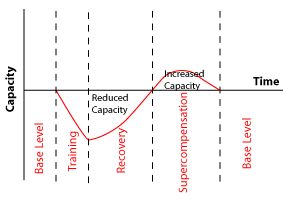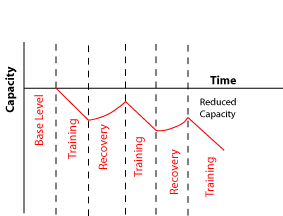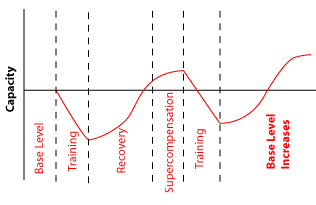How to Avoid Bringing Your Martial Arts Training to a Screeching Halt…
Overtraining is a major problem for the serious martial artist, and especially for competitors who have to balance technical training sessions with sparring and additional conditioning, often in the course of a single day.
All this hard training can result in the body breaking down faster than it can repair itself, which then – inevitably – leads to injury, illness, and the inability to train.
 If you scroll down this page you’ll see the full version of the detailed article about overtraining that I originally published in the now defunct Ultimate Athlete Magazine, way back in March 2003.
If you scroll down this page you’ll see the full version of the detailed article about overtraining that I originally published in the now defunct Ultimate Athlete Magazine, way back in March 2003.
That article got a really good reception, and all the information in it is still true today. Besides, some messages definitely bear repeating, especially given the rise of professional martial artists who basically do nothing but eat, sleep and train.
The dangers of overtraining not having diminished, I recently addressed the topic on both on my Youtube channel and on my podcast and thought that it would be beneficial to combine the video, audio, and written commentary all onto a single page – this one.
The video in which I rant about overtraining is right below…
To listen to this podcast, the best thing to do is to subscribe to The Strenuous Life Podcast using the podcast player that you almost certainly already have on your phone!
(For example, if you have an iPhone then it’s the purple app with the antenna-like thing in it. Just click the Apple Podcasts link below and it should open up that app for you.)
Here are the links to find the podcast on various players …
- Apple Podcasts (the purple app on your iPhone)
- Google Podcasts (the new google podcast app)
- Spotify (it’s free)
- Stitcher,
- Soundcloud,
- Google Play
And if you want to read the original article, then scroll on down!
The hard time for the training is already passed” – Rickson Gracie in Choke, before the 1995 Japan Vale Tudo Fighting Championship
Many fighters find that they always come down with a cold or injury before a competition.
This is often attributed to bad luck, but luck actually has very little to do with it. Most of the time these setbacks are due to overtraining, which is defined as a systemic deficit resulting from the stress of excessive training.
In plain English this means that training is breaking your body down faster than you can recover from it. The pernicious pre-competition flu, therefore, is due to overly severe training and/or insufficient recovery, reducing the body’s ability to repel infections.
The purpose of this article is to investigate and summarize the phenomenon of overtraining, particularly with regard to combat athletics. One important goal is to alert you to some important signs and symptoms of overtraining, allowing you to cut back on your training before it is too late.
THE PHENOMENON OF OVERTRAINING
| “Overtraining breaks you down before you reach the starting line. Undertraining breaks you down before you reach the finish line” – Bob and Shelly-lynn Glover, The Competitive Runner’s Handbook |
To prevent overtraining it is important to understand the stress response model. The basic model shows that one’s capacity for performance actually decreases during and immediately after training. Recovery brings one up to one’s previous capacity. With further rest one then enters into the supercompensation phase, where the mind and body perform better than they did before the training.

Figure 1: Athletic response to training, including recovery and supercompensation stages
If the training is too severe, or the time for recovery is too short, then the effect of workout after workout is a cumulative loss of capacity, leading to overtraining. Supercompensation never gets a chance to occur.

Figure 2: Diagram of overtraining, in which recovery is insufficient and supercompensation never occurs.
To increase athletic capacity, training stimulus must follow training stimulus at the correct interval.
If the recovery period is too short, or the training too severe, then overtraining results. But if the recovery period is too long then the base level of capacity never actually increases.
The correct approach to cumulative supercompensation is shown below. In this process the athlete’s baseline level gradually increases over time.

Figure 3: Gradual increase of athletic baseline capacity in response to training, recovery and supercompensation.
Supercompensation is vital for tapering prior to competition. Following a vigorous training regimen it is almost inevitable that some there will be some sort of overtraining.
If the taper is correctly executed then the athlete will rebound, his body and mind supercompensate, and he will find himself at a new capacity level by competition time. Keep in mind that it can literally take months to recover from severe overtraining, especially if injuries or illness are involved. The athlete should therefore make sure that his reserves can be completely refilled in the taper period, which is typically 10 to 14 days long or even longer for extreme events (marathon, etc).
SIGNS AND SYMPTOMS
| “Overtraining is a lack of enthusiasm for the sport of wrestling” – Ken Chertow, US National Wrestling Team member 1986-93 |
Many books and articles about overtraining simply list off a long list of ‘possible symptoms of overtraining’ and leave it at that. This list is somewhat informative, and may include some or all of the following general symptoms:
” Fatigue
” Reduced concentration
” Apathy
” Insomnia and/or troubled sleep
” Irritability
” Depression
” Decreased performance
” Delayed recovery from training
” ‘Intolerance’ to training
” Elevated/decreased morning rested pulse
” Increase in injuries
” Chronic muscle soreness
” Weight loss
” Frequent minor infections
” Appetite loss
” Decreased enthusiasm for training
There is a major shortcoming with a list of signs and symptoms such as presented above: it is far too general and vague.
Your typical grappler or MMA competitor wants to train, train, and train some more. There are so many facets to become competent in at the same time (i.e. strength training, aerobic and anaerobic training, muscular endurance conditioning, punching, kicking, throwing, pummeling, submissions, defenses, etc) that he doesn’t want to take any time off. He often feels that several days of rest from training will allow his opponent to get an edge on him. Thus the competitor usually ignores symptoms of overtraining, especially if they are presented as some sort of wishy-washy list of vague symptoms.
Sports physiologists have attempted, without much success, to identify changes in blood chemistry associated with overtraining. They have investigated the relationships between overtraining and hypothalamus function, amino acid imbalances, cortisol and catecholamine levels.
Perhaps because overtraining is such a complex phenomenon the results to date have been inconclusive. Currently there is no proven chemical test for overtraining although I wouldn’t be surprised if this changed in the near future as quantified self practitioners track an endless number of physiological variables and share them with each other.
Right now there are two very useful and practical categories of signs and symptoms of overtraining:
- Signs and symptoms that you have overtrained in the past. These are ’20/20 hindsight’ signs and symptoms. If you think that they apply to you then you should rethink your current and future training to avoid doing it again
- Signs and symptoms that you are currently overtraining. You can use this information to immediately cut back on (or take a short break from) your training.
Signs and symptoms that you have overtrained in the past include the following:
A. Best performances occur after short notice. It sometimes happens that a ‘chronically fit’ athlete – someone who is pretty active most of the time – enters a competition on very short notice and does very well.
This is often puzzling to the athlete, who has such a work ethic that he believes he needs up to 2 months of gut-busting, balls-to-the-wall, all out workouts to do his best.
One possible explanation is that the normal 2 month training regimen does more harm than good. His normal pre-fight conditioning routine may improve some aspects of his fitness, but negatively impacts his health, energy level and mental attitude.
In other words, if the athlete is given a lot of notice for an upcoming event he may totally overtrain for it, doing worse than if he had just maintained his normal activity schedule. The current wisdom is that it is better to be undertrained than overtrained.
B. Sickness before competition. In many people overtraining tends to manifest itself as respiratory tract infections (i.e. flus, colds, bronchitis or sinusitis).
It is well documented that strenuous competition leads to impaired immune system function. Among marathon runners, for example, almost 15% of them catch a cold in the week following a race, whereas only 2.2 % of runners who trained for the same race, but did not compete, became ill. Obviously really severe training too close to your event could have a similar negative effect on your immune system.
You’ve got to train hard to be successful, but the time for hard, burnout training is not the week before the event. Marathoners, for example, begin tapering two weeks before an event, and typically only do easy running for the last 7 to 10 days.
C. Training injuries. Every athlete will have his weak link, the part of his mind-body system that will break down first when exposed to heavy stress/overtraining. For some people heavy training stress manifests itself as lower back pain, for others their knees start to ache, etc.
If it seems like you have been injured every time that you have competed then it might be time to rethink your training program to avoid overtraining.
D. Another sign of past overtraining is underperformance.
Underperformance is when you don’t live up to your potential in competition. Perhaps you got caught with something that you could counter every time in training. Perhaps you just didn’t feel sharp or on the ball.
It should be kept in mind that there are many other reasons why an athlete may not do as well in competition as in training (‘choking’, nerves, overtraining, etc), but overtraining is certainly a major contributor to underperformance.
Insufficient recovery and overtraining may have dropped your performance capacity. Proper training and tapering protocols can fix this problem.
E. Another sign that you have overtrained in the past is the phenomenon of delayed peaking. Many athletes report feeling fantastic and energized a week or so after an important competition.
Now imagine if he had peaked a week earlier and got to compete in that energized state! This is a prime indicator of insufficient tapering, and the remedy is very simple. If the athlete had a 5 day tapering schedule before and felt great 1 week after the fight, then the next time he should have an honest (i.e. not too strenuous) 12 day taper prior to the next competition.
Signs and symptoms that you are overtraining right now include:
A. Increased resting heartrate. One efficient and relatively objective method of detecting overtraining is monitoring resting heartrate. This is best done in the morning before getting out of bed.
The most common type of overtraining (called ‘sympathetic’ overtraining) results in an elevated morning heartrate. If your heartrate is elevated by 10%, or about 5 beats per minute, above your normal rate, then you have a clear indication that you are either overtrained, or sick, or both! Time for an unscheduled rest day.
There is also another form of overtraining, ‘parasympathetic’ overtraining, that is associated with a decreased resting heart rate. This occurs because the athlete has been overtraining for so long that his hormonal and nervous systems become exhausted. This is fairly rare for martial competitors and really only occurs endurance athletes with extreme training volumes.
B. Increased time for heartrate to recover between intervals. An ex-professional football player told me that his most certain sign of overtraining came during sprint work. If after doing sprint intervals (i.e. 100 meter intervals, hill sprints, etc) it took longer than normal for his heartrate to drop between intervals, then he knew that he was overtrained.
For example, suppose you normally do repetitive 400 m sprints, allowing your heartrate to drop to 110 before starting your next sprint. Suppose you know your recovery time is normally between 2 and 3 minutes. If you find yourself waiting 4 or 5 minutes for your heartrate to come back down to 110, then you are probably overtrained.
C. Increased heartrate for a given training intensity. There are formal protocols one can use to measure the relationship between heart rate and level of exercise (lactate curves, etc). An athlete might want to use a fairly challenging, 10 to 15 minute session on a Stairmaster or treadmill, and record his final heartrate.
Doing exactly the same workout (same speed, same inclination, etc.) every week or two will allow the athlete to track his heartrate in response to a given stimulus. If the final heartrate keeps decreasing then the athlete is getting fitter. If the final heartrate is increased relative to the weeks before, the athlete is probably sick and/or overtraining and should cut back on his training immediately!
Similarly, if you can normally maintain a given pace (e.g. 7 minute miles for 4 miles) or a given heartrate (e.g. 160 beats per minute for one hour) and you find that you can no longer maintain the pace or the rate, then you are probably overtrained.
Obviously some common sense is also required: if you did heavy squats on Wednesday, don’t expect to maintain a fast pace on Thursday. Then again, you probably shouldn’t be doing hard sprint work the day after you do heavy squats anyhow, given the intense physiological and hormonal toll of heavy lifting!
These approaches require you to have a given, specific workout that you can use as a gauge of your condition.
In the past I have often used a long set of stairs as a personal marker. These stairs are an all-out 2 to 3 minute effort to climb, making them a perfect test for anaerobic capacity (ATP and lactate system). If my stair times are decreasing then I am probably improving; if my stair times are increasing, then I am probably overtrained.
D. Apathy, depression and lack of enthusiasm for training are subtle warning signs that are often overlooked by an athlete in training. These symptoms are very common in an overtrained athlete, but the athlete usually ignores them.
Apathy, depression and lack of enthusiasm are not necessarily the signs of a weak mind; they are physiological cues that your hormonal and endocrine systems are drained. If you don’t take some rest days or easy days immediately then you are shortly going to get sick or injured and have a concrete roadblock put in the way of your training.
Finally remember that every individual has different training needs and varying ability to recover from training. You need to carefully think about and personalize your training regimen to maximize results and minimize the chances of overtraining, illness, injury and other setbacks.
Hopefully this article gave you some clues as to designing the perfect program for you!
Click here for the second article in this series: Perfect Peaking and Tapering for Competition
Stephan Kesting is a BJJ black belt and an Instructor in Combat Submission Wrestling, Jun Fan/JKD, Majaphait Martial Arts and Kajukenbo Karate. Sign up for his free email newsletter about BJJ and martial art training by entering your email address below.
The post Overtraining in the Martial Arts appeared first on Grapplearts.
